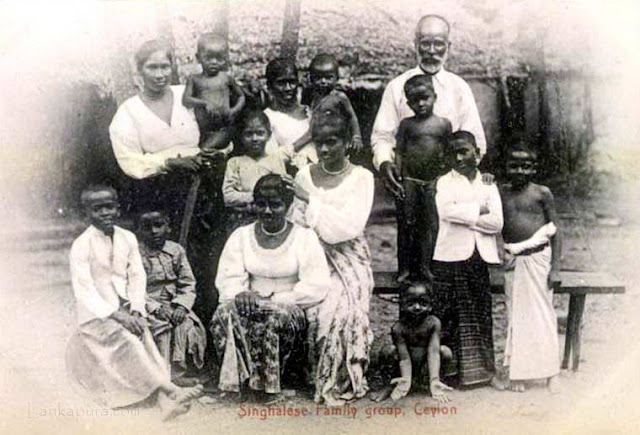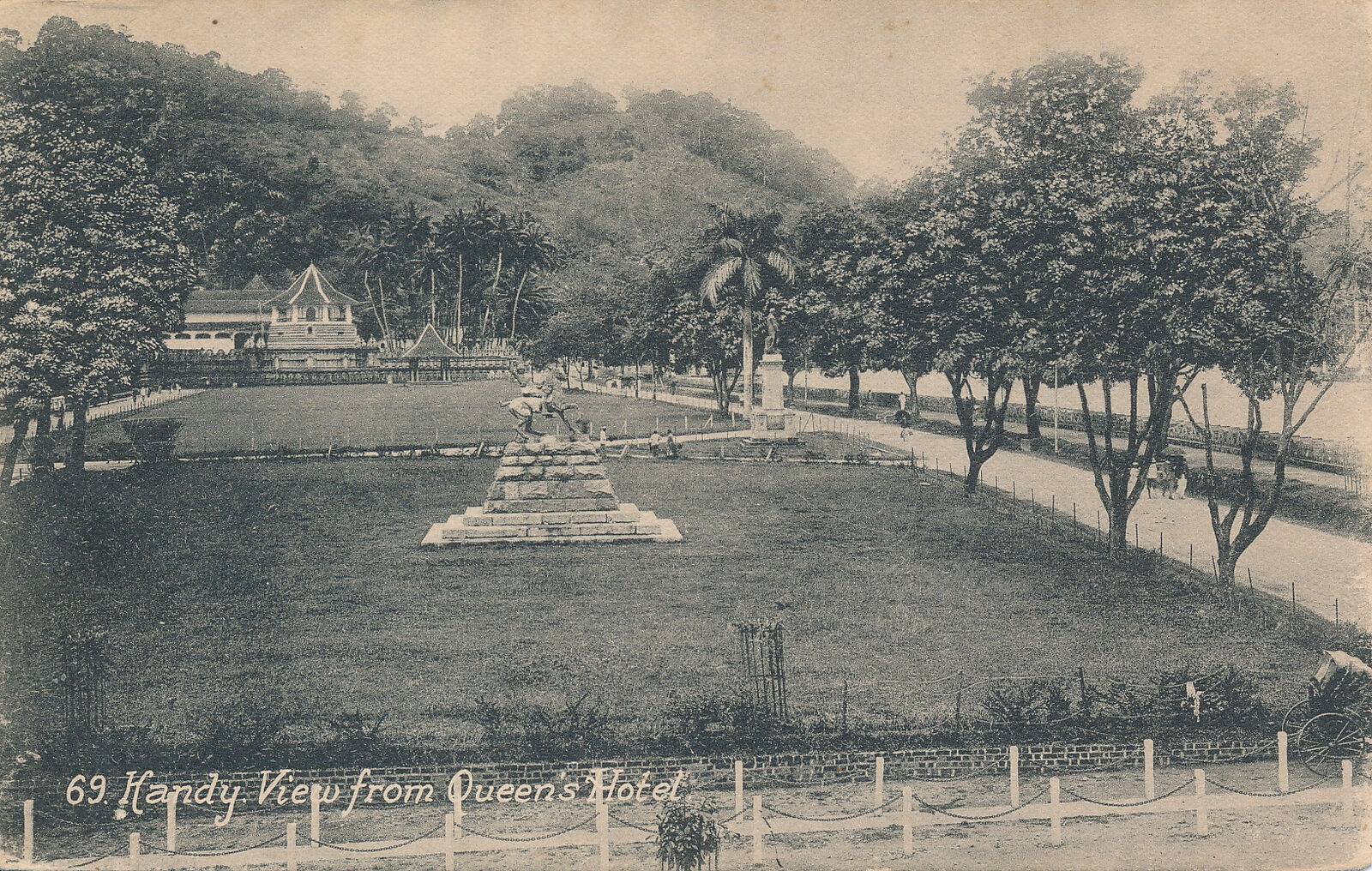Colombo - The Tamils and the Cinghalese
දමිළයෝ බොහෝ දෙනා කෙට්ටුයි, නමුත් සුන්දරයි. ඒ වගේම ක්රියාශීලියි. පහළ නැව් තටාංගනයේ දමිළයන් සිය ගණනක් හරි හරියට වැඩ කරනවා. එයාලා බත්තලන්වලට, නැව්වලට බඩු අදිනවා බඩු පටවනවා. කලවා අතරින් යැවූ පටු ඉණ කඩින් ඔබ්බට කිසිත් ඇඳ නෑ.
කොළඹ දමිළයන් සහ සිංහලයන්
 |
| Workers Dispatching Tea Boxes at Colombo docks (ca. 1885) photographed by Skeen & Co. [Image Courtesy: www.lankapura.com] |
ඒ ගොල්ලෝ සිංහලයන්ට වඩා ධෛර්ය්ය සම්පන්න, කාර්යක්ෂම පිරිසක්. ලොකු ලොකු වැඩ කළාට ඇඟ කෙට්ටුයි. බොහෝවිට කාල වර්ණ සමක් තියනවා. ඇස්වලින් සමාධිගත බවක්, යම් විටක රකුස් වෙස් ඇති බැල්මකුත් පෙන්නුම් කරනවා. ඒත් බොහෝ විට කඩවසම්. ඔවුන්ගේ අධිෂ්ඨාන ශක්තිය නම් පැහදිලිව පේන්න තියන දෙයක්. පහත් කුලවල ඉන්ද්රජාලවල ඉඳලා, උසස් කුලවල ගූඩ චින්තන ධාරා සහ විචාරාත්මක දෘෂ්ටි දක්වාම ගුප්තවාදය ඔවුන් අතර බහුලව තියන දෙයක් නිසා, මේ සියල්ලම එකට ගත්තොත් ඔවුන් බිහිසුණු ගතිගුණවලින් ද හෙබි ධෛර්ය්යමත් බවේ සංකලනයක්.
 |
| Tamil Family photographed by Plate & Co. (ca. 1900) [Image Courtesy: http://www.imagesofceylon.com] |
ලංකාවේ ඉන්න අශ්ව පාලකයන්, ඉස්තාල කොල්ලන් සියල්ලක්ම වගේ දමිළයන් (පහළ කුලවල). කළුපාටට හුරු, ක්රියාශීලී, හිතෛෂී, යක්කු රැළක් වගේ වුණාට ඉතා ප්රිය ජනක කණ්ඩායමක්. තමන්ගේ අස්සයන්ට හරිම ආදරෙයි. ඒ වගේම තමයි අලුතින් ගල්තාර දමාපු පාරක වුණත් සීමා රහිත හැකියාවක් දක්වමින් දුවන්න පුළුවන්. තේ කූලිලා පවා දමිළයන්. ඒ වගේම මාර්ග තනන කම්කරුවන් වුණත් දමිළයන්. සමස්තයක් වශයෙන් කුලියට වැඩකරන ශ්රමිකයො හැමෝම වගේ දමිළ.
 |
| Native Sinhalese Family (ca. 1900) [Image Courtesy: www.lankapura.com] |
මේ අතර මේ දූපතේ සෑහෙන කාලයකට ප්රථමව ස්ථාපිත වෙච්ච සිංහලයෝ, ඔවුන්ගේ පිටිසර කුඩා ඉඩ කඩම් රැක ගෙන ජීවත් වෙනවා. ස්වාමියෙක්ගෙ අණසක යටතට යන්න කොහෙත්ම නැඹුරුවක් නෑ. ඇත්තටම ඊට වඩා ඒ ගොල්ලෝ කැමතියි නිරාහාරව ඉඳල දුක් විඳින්න.
|
|
 |
| Group of Natives (ca. 1900) photographed by Scowen & Co. [Image Courtesy: www.imagesofceylon.com] |
සිංහලයන් හා දමිළයන් සෑහෙන විදිහට පැහැදිලි වෙනස්කම් පෙන්නුවත්, මේ ගොල්ලො මේ දූපතේ සුහද කොන්දේසි යටතේ වාසය කළත්, සම්මතයක් විදිහට ඔවුන් අතර ඇති ආදරය නම් නැති වෙලා නෑ. දන්න හැටියට සිංහලයන් ලක්දිවට පැමිණෙන්නේ ක්රි.පූ. හයවන සියවසේදි ඉන්දියානු මහා භූමි භාගයේ ඉඳලා. ආදි වාසීන් ටික මහවනයටයි කඳුකරයටයි තල්ලු කරලා (ඔවුන් සමහරක් තවමත් හොයාගන්න පුළුවන්), ඒ ගොල්ලෝ මුළු දිවයිනම තමන්ගේ යටතට ගන්නවා. ඒ ඉන්දියාවෙම ඉන්න දමිළයන්ට ඒකම අනුගමනය කරලා ලංකාවට පැමිණෙන්න වැඩි කාලයක් ගියේ නෑ. එවක් පටන් ඇතිවුණු ගැටුම් මාලාවකටම පස්සේ, පසුව පැමිණි අයවලුන්ටත් ඔවුන්ගේ ස්ථානය ආරක්ෂාකරගෙන ඉන්න පුළුවන් වුණා. එයාලා දැන් දිවයිනේ උතුරු ප්රදේශයේ ජනගහණයෙන් සෑහෙන ප්රතිශතයක් නියෝජනය කරනවා. ඒ අතර සිංහලයන් බහුතරයක් වෙසෙන්නේ දකුණු ප්රදේශයේ. දමිළ ගැමියෝ බහුතරයක්; මිනිස්සු තම කාන්තාවන් හා දරුවන් සමඟ; තවමත් ඉන්දියාවේ සිට හැම අවුරුද්දක් පාසාම උඩරට තේ වතුවල වැඩ කරන්න මෙහි පැමිණෙනවා. මොකද කුලී කම්කරුවන් සඳහා උඩරට සෑහෙන ලොකු ඉල්ලුමක් තියන හන්දා.
 |
| Ceylan, portrait de villageois (ca. 1875) photographed by Scowen & Co. [Image Courtesy: www.artvalue.com] |
සිංහලයන්ගේ චරිත ස්වභාවය ගත්තොත් එයාලා ටිකක් ඉතාලියානුවන් වගේ. කලබල නැති, පෙළක් වෙලාවට නිකම් ඉන්න, සංවේදී, විචක්ෂණශීලී, ඒ වගේම ටිකක් ආදරවන්ත කට්ටියක්. ඔවුන්ගේ විශාල ඇස්, කැස්බෑ පොතු නැමි පනාව, දිග කොණ්ඩය වගේ දේවල් ඔවුන්ට කාන්තා ගතියක් ලබා දෙනවා. බොහොමයක් පිරිමි ළමයින්ටයි තරුණයන්ටයි වුණත් තියෙන්නේ බාලිකාවන්ගෙ මුහුණුවරක් සහ භාව ප්රකාශනයක්. එයාලා හැමවිටකම වගේ ශිෂ්ට, ප්රතාපවත් පැවැත්මකට අනුවයි ජීවත් වෙන්නේ. හොඳ පෙළපතක නම් ඒකාන්තයෙන්ම ඔහු කඩවසම්. ඔවුන්ගේ හොඳට වැඩුණු විශාල හිස, දැලි රැවුල, දිගු කලු කොණ්ඩය, උපශාන්ත බව, ආචාරසම්පන්න බව අපට මතක් කරවන්නේ ජේසුතුමන්ගේ සමහර ඡායාරූප. පහළ පෙළපතක අයට නම් ගොරෝසු මුහුණුවරක්, දුර්මුඛ සංවේදී කමක්, උදාසීන ගතියක් හිමිවෙනවා. සම්මතයක් විදිහට දමිළයන්ට වඩා ඔවුන්ගේ දේහ සැකිල්ල තරමක් විශාල සහ මස් පිඬු සහිත බවක් පෙන්වනවා. නමුත් යහපත් පිළිවල සහ වැදගත් බව හැඩහුරුකමින් පෙන්නුම් කරන්නේ ඉතා අඩුවෙන්.
|
කපිතාන් ආර්. නොක්ස්, ඔහුගේ "කන්ද උඩරට රාජධානියේ දහනම වසරක සිර අඩස්සිය (1681)" නැමැති කෘතියේ ඔවුන් ගැන මෙහෙම කියනවා:- "ගමන සහ කල්ක්රියාව පෘතුගීසීන් වගේ බොහෝ ගම්භීරයි, ඒ වගේම ප්රතාපවත්. යමක් අවබෝධ කරගැනීමේදි, වේගයෙන් එය වහා තේරුම් ගන්නවා. නිර්මාණකරනයේදි ඉතා සියුම් සහ කලාත්මකයි. කථාවේදි, ආචාරශීලියි, ඒත් ආ වැඩීම් බොහොමයි. ස්වභාවයෙන්ම මත්පැන් බීමෙන් සහ මාංශ අනුභවයෙන් වැළකිලා ඉන්න නැඹුරුවක් තිබ්බට පතිවත රැකීමට නැඹුරුව අඩුයි. පවුලේ සකසුරුවම්කම ගැන සිතන අතර පවුලට බොහෝ සමීපයි. කෘෂිකර්මාන්තයට හරි රුසියන්.” |
සිංහලයන් ඔක්කොම වගේ බෞද්ධයෝ. එතකොට දමිළයන් බොහෝදෙනා හින්දු. බුදුදහම ලක්දිවට හඳුන්වාදෙන්නේ ක්රි.පූ හතරවන සියවසේදි. එතැන් පටන් බුදුදහම මහත්සේ මෙහි මුල් බැස ගන්නවා. බෞද්ධ ලෙන් විහාර ආරාම දූපත පුරාම දැක ගන්න පුළුවන්.
 |
| A large group gathers for a Buddhist ceremony at the Sacred Tooth Temple, Kandy, Ceylon (ca. 1880) photographed by ELIZA R. SCIDMORE/National Geographic [Adapter's Note: Looks like Burmese people were invited to worship sacred tooth of Buddha] |
“ආදම්ගේ ශිඛරය මතින් එලිෆන්ටා ගුහා වෙත – ලක්දිව සහ ඉන්දියාවේ රූප සටහන්” : එඩ්වඩ් කාපෙන්ටර්
පළමු පරිච්ඡේදය : කොළඹ
From Adam’s Peak To Elephanta : Sketches in Ceylon and India by Edward Carpenter
CHAPTER I : COLOMBO
The Tamils are mostly slight and graceful in figure, and of an active build. Down at the docks they work by hundreds, with nothing on beyond a narrow band between the thighs, loading and unloading barges and ships—a study of the human figure. Some of them of course are thick and muscular, but mostly they excel in a kind of unconscious grace and fleetness of form as of the bronze Mercury of Herculaneum, of which they often remind me. Their physiognomy corresponds with their bodily activity ; the most characteristic type that I have noticed among them has level brows, and eyes deep-set (and sometimes a little close together), straight nose, and well-formed chin. They are a more enterprising pushing and industrious people than the Cinghalese, eager and thin, skins often very dark, with a concentrated, sometimes demonish, look between the eyes—will-power evidently present—but often handsome. Altogether a singular mixture of enterprise with demonic qualities ; for occultism is rife among them, from the jugglery of the lower castes to the esoteric philosophy and speculativeness of the higher. The horse-keepers and stable boys In Ceylon are almost all Tamils (of a low caste), and are a charming race, dusky active affectionate demons, fond of their horses, and with unlimited capacity of running, even over newly macadamised roads. The tea-coolies are also Tamils, and the road-workers, and generally all wage-laborers ; while the Cinghalese, who have been longer located in the Island, keep to their own little peasant holdings and are not at all Inclined to come under the thumb of a master, preferring often Indeed to suffer a chronic starvation instead.
The Tamil women are, like their lords, generally of a slighter build than the Cinghalese of the same sex, some indeed are quite diminutive. Among both races some very graceful and good-looking girls are to be seen, up to the age of sixteen or so, fairly bright even in manner ; especially among the Cinghalese are they distinguished for their fine eyes ; but at a later age, and as wives, they lose their good looks and tend to become rather heavy and brutish.
The contrast between the Cinghalese and the Tamils is sufficiently marked throughout, and though they live on the island on amicable terms there is as a rule no love lost between them. The Cinghalese came to Ceylon, apparently from the mainland of India, somewhere in the 6th century B.C., and after pushing the aborigines up into the woods and mountains (where some of them may yet be found), occupied the whole island. It was not long however before the Tamils followed, also from India; and since then, and through a long series of conflicts, the latter have maintained their position, and now form the larger part of the population in the north of the island, while the Cinghalese are most numerous in the south. Great numbers of Tamil peasants—men, women, and children—still come over from the mainland every year, and go up-country to work in the tea-gardens, where there is a great demand for coolie labour.
In character the Cinghalese are more like the Italians, easy-going, reasonably idle, sensitive, shrewd, and just a bit romantic. Their large eyes and tortoise-shell combs and long hair give them a very womanly aspect ; and many of the boys and youths have very girlish features and expressions. They have nearly always grace and dignity of manner, the better types decidedly handsome, with their well-formed large heads, short beards, and long black hair, composed and gentle, remindful of some pictures of Christ. In inferior types you have thick featured, morbidly sensitive, and at the same time dull-looking persons. As a rule their frames are bigger and more fleshy than those of the Tamils, and their features less cleanly cut. Captain R. Knox, in his " Nineteen Years' Captivity in the Kingdom of Conde Uda" (1681), says of them : — "In carriage and behaviour they are very grave and stately, like unto Portuguese ; in understanding quick and apprehensive ; in design, subtle and crafty ; in discourse, courteous, but full of flatteries ; naturally inclined to temperance both in meat and drink, but not to chastity ; near and provident in their families, commending good husbandry."
The Cinghalese are nearly all Buddhists, while the Tamils are Hindus. Buddhism was introduced into Ceylon about the 4th century B.C., and has flourished here ever since ; and Buddhist rock temples are to be found all over the island.
ලක්දිව ගමන් සටහන් පිටු අංක : 5








Comments
Post a Comment